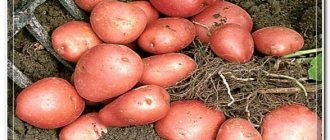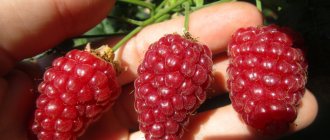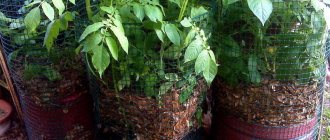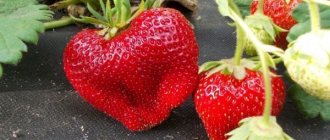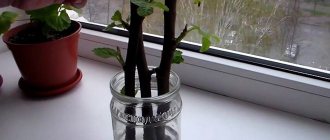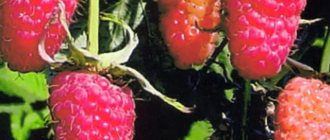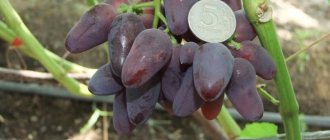Cherry Nochka - what kind of variety is it?
According to the description of the variety, Nochka cherry is considered a very unusual crop, which belongs to the Dukes. One of the plant's parents is cherry. As a result of crossing it with cherry, it was possible to obtain a tree with the characteristics of the parent crops.
Main characteristics of culture, advantages and disadvantages
A distinctive feature of the culture is the shape of the cherry crown and the branching of the cherry. Nochka forms flower buds during annual growth. This promotes early flowering of the crop.
The height of the tree reaches 3 m. It is characterized by dark green leaves with a glossy surface. The flowers are saucer-shaped.
The tree of this variety is quite large in size.
Cherevishnya Nochka has fairly large berries, the weight of which reaches 7 g. They form a cluster of 6-8 fruits. The first harvest can be obtained in the 3rd year of life. Dark burgundy fruits are characterized by a pleasant cherry taste and a pronounced cherry aroma. However, they do not have the cherry tartness.
Duke's shoots are smooth and straight. They are covered with dark brown bark. Cherry buds are similar in appearance to cherry buds. However, the flowering period begins a little later - in mid-May. During this period, warm weather sets in and the threat of return frosts passes.
The advantages of a hybrid include the following:
- high frost resistance;
- the presence of immunity to various pathologies, including coccomycosis;
- tolerance to hot and dry summers, no need for frequent watering;
- wonderful taste of berries;
- low maintenance requirements.
If Duke Nochka cherries are grown, the description of the variety includes some disadvantages:
- self-sterility - this means that the crop requires pollinating cherries;
- low yield;
- the large size of the tree makes it more difficult to care for and creates problems with harvesting.
Cherry agricultural technology: features
Because of their advantages, hybrid varieties are popular among gardeners, and Nochka will be no exception.
To get a harvest, it is important to choose and plant seedlings correctly, and then provide them with proper care.
Selection of seedlings and planting
To purchase, it is better to take advantage of offers in the catalogs of specialized nurseries. One-year-old cherries with strong shoots and well-developed roots are suitable. The best time for planting is spring, since cherries take root faster during this period and are not as susceptible to stress as during autumn planting.
But the time frame is short, it is important for the gardener to get within the period from the thawing of the soil, the onset of heat and before the buds open.
In central Russia, cherries are usually planted in the middle or end of April, focusing on the weather of a particular year. Soil temperature – at least +14ºC…+15ºC, air temperature – above +10ºC. If the temperature is below +10ºC, the plants enter a dormant period and the growing season slows down. In the south, trees are also planted in the fall, approximately 30-35 days before the onset of cold weather.
Site requirements:
- well-lit sunny place;
- lack of shadow;
- slope slope – no more than 6-7º;
- The groundwater level is no higher than 1.6-2 meters.
Low-lying areas and places with cold air are not suitable for Duke. In the middle zone and regions with cold climates, it is recommended to plant near buildings and fences that protect fruit trees from the winds.
The Nochka variety grows well and bears fruit on light sandy loam soils, chernozems, and loams. The soil should be loose, breathable, with a neutral pH. Acidic soils are not suitable; they are cultivated by adding dolomite flour or wood ash.
ON A NOTE! When planting in spring, the site is prepared in the fall by applying fertilizers and digging planting holes.
The distance between the holes is at least 4 meters, since the dukes are distinguished by good growth and a wide crown. The dimensions of the holes are 90x90 cm on fertile soils, and larger on heavy soils, 100x100 cm or 120x120 cm.
The depth of the hole is dug to 50 cm. A nutrient mixture is prepared: the soil from the hole (usually the top layer is taken) is mixed with humus, wood ash, and superphosphate. Proportions: add about 1 kg of ash and 60 grams of superphosphate to 2 buckets of organic matter.
The holes are watered, a layer of mixture is laid, lightly compacted, and a support for the seedling is installed - a strong stake (length - 150 cm). Then the seedling is placed, straightening the roots, making sure that the root collar is above the soil surface (8-10 cm). The roots are carefully sprinkled with soil and the remains of the nutrient substrate, spilled, and the hole is filled to the top.
The soil around the tree is compacted again and mulch (compost, humus) is laid. The seedling is carefully and loosely tied to the stake with a ribbon or braid.
ATTENTION! For pollination, seedlings of other varieties of cherries are planted near Nochka. There should be no other fruit trees (for example, apple trees) between plantings. Gardeners dip cherry roots in special solutions before planting seedlings.
The technique is effective for trees that have a weak root system or were not purchased in containers. They use the preparations Zircon, Kornevin, and also soak the roots in a solution of potassium permanganate for disinfection.
Before planting seedlings, gardeners dip the cherry roots in special solutions. The technique is effective for trees that have a weak root system or were not purchased in containers. They use the preparations Zircon, Kornevin, and also soak the roots in a solution of potassium permanganate for disinfection.
History of hybrid selection and region of breeding
The culture was developed by the Honored Agronomist of Ukraine L. I. Tatarenko. She created many new varieties of cherries, peaches, quinces, and apricots.
Nochka was obtained by cross-pollination of the hybrid cherry variety Nord Star and the large-fruited cherry Valery Chkalov. As a result, it was possible to develop a plant that is resistant to drought, pathologies and frost.
Note! Hybrids that were obtained by cross-pollination of cherries and sweet cherries are called dukes. They are also often called cherry.
Harvest
Nochka’s berries ripen in July, and since the variety is universal, they are used both for processing and consumed fresh.
IMPORTANT! For consumption (without storage or transportation), the berries are removed in a state of consumer (full) ripeness. For transportation - approximately 4-7 days before full ripeness.
The Nochka variety is a hybrid cherry that is valued by gardeners in various regions. Its advantages: excellent taste of the fruit, high resistance to low temperatures, diseases, and easy care.
Growing technique, planting and subsequent care
In order for the plant to be successfully grown, it is recommended to carry out planting work correctly.
Optimal soil types
Duke is best planted in fertile soil, which is slightly acidic. In this case, a well-lit area that has reliable protection from the wind is suitable for planting.
Reproduction methods
The plant can be propagated by vegetative methods. This is done by cuttings, grafting or layering. Seed or generative propagation should not be used, since it will not be possible to obtain the desired variety.
Cuttings are best carried out at the end of August or at the beginning of September. Shoots must be taken from the lower branches. After which they should be placed in a box with a growth stimulator. After which it is necessary to plant the plant in the garden bed, cover it with a jar and systematically water the plantings.
Pruning and crown formation
Sweet cherries are characterized by rapid growth before the fruiting period begins. This feature of the hybrid forces gardeners to carry out timely sanitary pruning. They need to be done in spring and autumn. In this case, the first annual shoots need to be cut by a third.
It is also necessary to remove dried and frozen branches.
The crop needs timely pruning
Characteristics
- The hybrid has a good early fruitfulness; 3–4 years after planting, the tree produces its first harvest;
- drupes ripen in late June - early July;
- the yield is low, according to various sources - from 10 to 12 kg per tree, but with good care, some sources promise up to 20 kg. The peak of fruiting occurs in the 12th year of the Duke’s life;
- Nochka's frost resistance is very good; the tree can easily withstand frosts of -35°C. This feature allows you to grow this variety even in Non-Black Earth conditions;
- Cherry's immunity is quite strong - it is resistant to moniliosis, anthracnose, and clasterosporium blight. But in unfavorable years and in the absence of preventive treatment, it may suffer from coccomycosis;
- the variety is quite resistant to dry periods;
- if you remove the drupes along with the stalk, the berries will withstand transportation;
- The fruits of this variety are most often used in their natural form or as a dessert. But they can also be processed and made into excellent preserves, marmalade, and compote. In addition, the drupes are dried and frozen.
Features of wintering a tree
Despite good resistance to frost, when the temperature drops significantly, the plant needs to be covered. To protect the tree from the cold, you will need snow mixed with sawdust. It needs to be raked up to the trunk all the time.
Important! To protect trees from rodents, the trunk can be wrapped in several layers of burlap. It is permissible to use roofing material on top.
Nochka cherry is a popular garden crop, which is distinguished by its tasty fruits and resistance to frost. For a culture to develop normally, it requires adequate care.
Advantages and disadvantages of the variety
Hybrid Nochka has absorbed the best properties of its parent forms. Its advantages include:
- frost resistance (withstands temperatures down to minus 30 degrees Celsius);
- large-fruited (berries weigh on average 7 grams, some specimens reach 10 grams);
- excellent taste and aroma of fruits;
- drought resistance;
- resistance to such insidious diseases as coccomycosis, moniliosis.
With proper care, Nochka is not afraid of diseases such as anthracnose, clasterosporiasis, and milky sheen.
Flaws:
- the hybrid is self-sterile, so certain varieties are planted with it for pollination: Molodezhnaya, Nord Star (cherries);
- low yield (9-10 kg of berries are collected from a tree).
There are many varieties that are superior to Nochka in terms of yield, but it has its own “advantages”, and the most important ones are frost resistance and high taste.
Reviews about the variety
And I planted the “Nochka” variety. It has large, sweet and sour fruits. In addition, this duke is frost-resistant and partially self-fertile. Although for a stable, high yield, a pollinator is needed, for example the Turgenevka or Ksenia variety. “Nochka” is also resistant to some diseases, such as coccomycosis.
Zira
https://www.lynix.biz/forum/sorta-dyukov
My grandmother, in the Voronezh region, and my husband in Kazan grows duke on the plot; to me it still looks more like a cherry, but a little sweeter. They, like cherries, are not afraid of cold weather. As far as I know, they grow varieties: Ivanovna and Nochka. They ripen towards the end of June. We grow them in an open area, there are a lot of berries, we brought them with us, froze them for compote, they don’t store well, or I stored them wrong, but the frozen compote is just superb. We grow them at a distance of about four meters from each other. Many of their varieties are self-sterile. Grandmothers still grow a self-fertile variety of cherries so that pollination occurs. Buy seedlings only from trusted places so that you know what kind of variety you have, otherwise they may slip in defective ones. The cultivation technology is almost the same as for common cherries, they just like a little more warmth.
Maria1982
https://www.lynix.biz/forum/sorta-dyukov
Of course, spoiled residents of the southern regions, among the variety of varieties of cherries, may not choose the Nochka cherry because of its low yield. But for Central Russia, right up to the Moscow region, this is one of the not so many options to enjoy juicy, large berries with the taste of cherries in your garden. And the relatively low yield of the variety is not a reason to refuse to choose this sweet cherry for planting. Even a novice gardener can plant and grow Nochka.
Growing cherry Nochka
Nochka berries will be sweet in a sunny area and very sour when grown in the shade and partial shade of trees and buildings. The variety does not tolerate dampness, so it cannot be planted under a fence or in other places where melt and rainwater stagnate. Place the seedling at a distance of 3–4 m from neighboring bushes and trees; retreat 2–3 m from the fence or building.
The landing itself is done according to the classical scheme. Add humus and phosphorus-potassium fertilizers or wood ash to the hole. Do not bury the root collar.
Video: planting cherries
Nochka does not need to be fertilized before fruiting begins, but watering will come in handy, especially in dry weather. In the first years after planting, the tree will begin to actively grow its crown and will require pruning and shaping from you. Dukes are shaped like a tree, but with a short stem. Therefore, already in the year of planting, the seedling needs to be shortened not to 70 cm, as is done with trees, but to 30–40 cm.
Duke Nochka is formed like a tree: into one trunk with a small trunk and skeletal branches
Further shaping involves choosing skeletal branches: leave those extending from the trunk at an angle of more than 45 degrees and cut those growing at an acute angle, directed downwards, upwards or into the crown. Then the tree will turn out to be spreading, each branch will be well warmed up by the sun and blown by the wind.
Read also: Black cherry: variety description, planting and care
Video: formation of a young Duke
From the moment Nochka enters fruiting, annual measures to care for her will be:
- Water if the weather is hot and dry during the periods of flowering and ovary growth. In regions where it rains every 1–2 weeks, this variety is grown without irrigation.
- Feeding: in spring - nitrogen-containing fertilizer (infusion of weeds, mullein, droppings, solution of ammonium nitrate or urea);
- during the period of budding and flowering, use a complex ready-made mixture for fruit and berry crops (Fertika, Agricola, Clean Sheet, Florizel, etc.) or wood ash (powder the soil, loosen it and water it);
- in autumn - phosphorus-potassium fertilizers or wood ash.
Landing rules
The optimal time for planting cherries on the site is considered to be early spring, since if the procedure is carried out in the fall, fragile seedlings may freeze in the winter.
Read also: Cherry for the Moscow region: the best and popular varieties reviews
For this reason, it is advisable to preserve even specimens purchased in the fall until spring, placing them in a cool cellar for a while or digging them into the soil. When the time comes, the young plant is taken out of storage and, after a thorough inspection (you need to make sure the viability of the seedling), proceed to planting.
This process involves performing several sequential actions:
- 14 days before replanting, the soil in the selected area should be dug up and fertilized with organic compounds, and if the acidity is high, dolomite flour or fluff lime will have to be added to the substrate.
- A week before planting, you can dig a planting hole, the size of which in this case should be at least 60x60 cm.
- It is useful to mix the top layer of the removed soil with humus and sand, taken in equal proportions, and only then fill the bottom of the pit. The next layer will be a layer of ordinary soil (without fertilizers).
- A few hours before the planned planting of the cherry, the soil in the planting hole should be moistened so that by the time the seedling is placed, the moisture has already been absorbed.
- At the time of planting, the young plant must be held strictly vertically, with all its roots well straightened.
- From above, the root system of the seedling is covered with the remaining soil, but only so that the root collar remains above the soil level. All voids formed between the roots must be filled by simply compacting the substrate slightly.
- To complete the planting, make a shallow hole around the cherry tree and pour about 10 liters of water into it (if desired, you can mulch the tree trunk with sawdust or humus).
Video: planting cherries
How to care
For rapid growth and development, all trees need regular care, and cherries are no exception. Representatives of the described variety require compliance with the rules of watering, fertilizing, mulching and loosening, but you should pay particular attention to the issue of pruning trees.
The hybrid of cherries and cherries is pruned in the same way as cherries, shortening the annual growth by 1/3 of its length, which is useful for the correct formation of the crown. Let's take a closer look at all the features of caring for “Nochka”.
Watering
After planting a seedling on a plot, its root system begins to grow rapidly, which is why the plant needs regular and abundant watering. In dry times, you will have to water the tree at least three times a season, pouring at least 15 liters of water under each seedling.
Adult hybrids tolerate drought well, so there is no need for additional watering. You should not over-water the trees, as stagnation of moisture will cause rotting of the root system. Overmoistening leads to the appearance of cracks in the bark of the trunk and branches, resulting in gum formation.
Basic watering should be carried out only during the flowering of trees and ripening of fruits, and 2-3 weeks before the start of harvesting, it is advisable to completely stop adding liquid to the soil.
Feeding
The “Nochka” variety does not need frequent fertilizers, and if a sufficient amount of nutrients was added to the hole when planting, then the next fertilizing can be done only after five years. To prepare a nutrient mixture, it is enough to mix 0.5 buckets of mullein with two identical buckets of clean water and 0.5 kg of ash.
After a week of infusion and careful straining, this nutrient mass is simply poured under the tree, at the rate of 0.5 buckets per plant. To increase productivity, just two such fertilizings, performed in early spring and during flowering, are enough, and with the arrival of autumn, you can additionally scatter a mixture of phosphorus (200 g) and potassium (80 g) fertilizers around the perimeter of the crown.
Soil care
Mature cherries are quite resistant to external unfavorable factors, however, they also need periodic tillage of the soil in the tree trunk circle. Therefore, every time after watering, it is advisable to loosen the soil and remove weeds from it, and at the end of the procedure, you can mulch this area with peat, straw or slightly withered grass.
Mulching helps retain moisture and inhibits the re-development of weeds, but during rainy periods it is better to remove the layer in order to prevent stagnation of precipitation near the Nochka root system.
Trimming
Hybrid forms of cherries are characterized by very rapid growth before the fruiting period, so sanitary pruning is one of the mandatory and regular measures in caring for the described variety.
Typically, the procedure is performed in the spring and before wintering, removing all broken, dry and frozen shoots, and annual branches are cut to only 1/3 of their length. All work can be done with sharp garden shears, and it is advisable to immediately treat the cut areas with garden varnish.
Video: cherry pruning
Preparing for winter
As we noted earlier, the “Nochka” cherry is characterized by a fairly high resistance to cold, however, in case of severe frosts, it is advisable to organize a shelter (especially for young plants).
Snow mixed with sawdust will help protect the tree from the cold, which should be constantly raked under the trunk, but if there are also rodents in your garden, then you can wrap the trunk with several layers of burlap and wrap it with roofing material on top. It is advisable to protect young seedlings with metal cylinders, which are easy to find in gardening stores today.
Diseases and pests
Nochka has a very high resistance to coccomycosis, but can be susceptible to other fungal diseases (moniliosis, clasterosporiasis, scab) in the absence or insufficiency of preventive measures.
Prevention of cherry diseases and pests
Preventive measures are carried out, as a rule, in early spring and late autumn, during the period of absence of sap flow. The composition of these events differs slightly for different garden crops, so they are usually carried out simultaneously throughout the entire garden.
- Collection and destruction of fallen leaves, in which some pests and pathogens usually overwinter.
- Sanitary pruning of dry, diseased and damaged branches.
- If necessary, clean out any cracks in the bark, followed by disinfection with a 1% solution of copper or iron sulfate and treatment with a natural-based garden pitch (beeswax, lanolin, etc.).
- Digging up tree trunk circles with turning over the layer in order to lift up pests that have settled in the soil layer for the winter.
- Whitewashing trunks and skeletal branches with lime.
- Tying the trunks of young trees with roofing felt to protect against hares.
- Treatment with insecticides (drugs to control insects) and fungicides (antifungal drugs): DNOC - in early spring once every three years. From the vast majority of diseases and pests.
- Nitrafen (insecticide and fungicide at the same time, broad spectrum) - in early spring.
- Decis (insecticide) - in early spring and during the season when pests appear.
- Copper sulfate 3% solution - in late autumn and early spring.
- Iron sulfate 5% solution - in late autumn and early spring.
- Bordeaux mixture 3% solution - in late autumn and early spring.
Usually these measures are enough to prevent the cherry from getting sick and being attacked by pests. It is necessary to carefully monitor the trees during the season and, if signs of diseases or pests appear, take targeted action against them.
Possible diseases, signs and treatment
A gardener needs to know what signs of diseases look like and what to do when they appear.
Clusterosporiasis (hole spotting)
A fungal disease that usually appears in spring or autumn, because favorable conditions for it are high humidity and an air temperature of 20–25 °C. Fungal spores overwinter in bark and fallen leaves and are also spread by insects and wind. It flows quickly. It takes two weeks from the appearance of small black dots on the leaves to their growth in a red-burgundy circle. Then parts of the sheet inside the circles dry out and fall out, forming holes. The leaves dry out and fall off.
Two weeks after infection with clasterosporiasis, holes appear on the cherry leaves
If the disease is detected before flowering, you can treat the tree with nitrafen, even if it has already been used in early spring. After flowering and during the season they are treated with biofungicides:
- Horus. Up to three treatments per season. The latter no later than seven days before harvest.
- Quadris. Up to three treatments per season. Last 3-5 days before harvest.
- Speed Up to three treatments per season. The last one is 20 days before harvest.
Moniliosis (monilial burn)
Fungal spores are first introduced in the spring by bees during flowering. The fungus penetrates through the pistil of the flower into the stalk, leaf, and shoot. As a result of the defeat, they turn black and sag, the tree looks like it has been burnt. In summer, the fungus manifests itself as fruit rot, affecting the berries, which become mummified. If measures are not taken, the tree may die.
The methods and methods of control, the drugs used, are the same as for kleasterosporiasis. In addition, if shoots are damaged, they must be immediately cut into 20–30 cm of healthy wood or even “into a ring.” The affected parts of the plant (flowers, ovaries, leaves, shoots) are immediately collected and destroyed.
Photo gallery: cherry moniliosis
Cherry pests
Cherries have their own pests, which are called: cherry sawfly; cherry weevil; cherry aphid; cherry fly.
Cherry slimy sawfly
Outwardly, it resembles both a slug and a caterpillar, but, compared to the first, it is smaller in size (4–6 cm). There are many varieties of sawflies, but all of them, or rather their larvae, eat away the juicy part of the leaf blade, leaving veins. If not stopped in time, the larvae will eat most of the leaves, which will eventually turn yellow and fall off prematurely. The tree will go into winter weakened. The larvae overwinter in the soil, emerge in the spring and lay eggs on new, young leaves.
The cherry sawfly larva looks like both a caterpillar and a slug
Since the sawfly does not cause significant damage, they usually fight it using non-chemical means - collecting the larvae by hand, washing them off with a stream of water, digging up the soil in the fall, etc. The use of insecticides is resorted to only in case of mass destruction.
Cherry weevil
Beetles and weevil larvae overwinter in the soil around the tree trunk. In early spring they come to the surface and climb a tree. Beetles eat flowers, leaves, and young shoots. At night and early in the morning, when the temperature does not rise above +5–8 °C, the beetles sit on branches without moving. At this time, you can simply put them on a spread cloth or film, collect them and destroy them. But once the temperature rises above 10°C, this opportunity will be lost. The beetles will wake up and the technique will not work.
To prevent various beetles, caterpillars, and ants from climbing to the crown, you can install trapping belts in the lower part of the trunk.
Further fight can only be made with the use of insecticides (Nitrafen, Decis, Fufanon, etc.).
The cherry weevil feeds on cherry flowers, berries and leaves.
Cherry aphid
As you know, aphids are carried onto trees by ants. Therefore, first of all, you need to take care of destroying anthills on the site and installing hunting belts on tree trunks. In addition, systemic insecticides such as Iskra and Fitoferm are used, which are not toxic to humans and animals.
Cherry aphids are brought to the tree by ants
cherry fly
Overwinters in the top layer of soil in the form of a pupa. With the onset of warmth, it comes out and at first feeds on the sweet secretions of the cherry aphid, after which it lays eggs and the caterpillars that hatch from them eat ripe cherry berries. The main advice is to destroy the cherry aphids and you will not have cherry flies. She simply will have nothing to eat after waking up and will fly off to other gardens to look for food.
The cherry fly overwinters in the soil of the tree trunk
